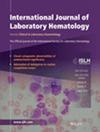The effect of oscillation depolymerization on ethylenediaminetetraacetic acid-dependent platelet aggregation samples: A cross-over study
Abstract
Introduction
Ethylenediaminetetraacetic acid (EDTA)-dependent platelet aggregation (PA) can cause medical errors. Currently, there is no reliable method for completely solving this problem. This study aims to solve this problem that has plagued clinical practice for many years by using oscillation method.
Methods
Sixty-one EDTA-PA samples were collected, divided, and disaggregated using the oscillation method at various times and speeds. The samples were analyzed using routine blood tests and blood smears.
Results
Platelet counts (PLT) were increased significantly after oscillation. PLT in the 3000 rpm for 0.5 min group was significantly higher than that in the 500 rpm for 0.5 min group (p < 0. 01). After 3000 rpm oscillation, the PLT gradually increased with time, while compared with the 10-min group, the PLT in the 13-min group showed no significant differences. The effective disaggregation rates in the EDTA-PA samples using the oscillation method and sodium citrate anticoagulant were 96.72% and 65.57%, respectively. There were no significant changes in white blood cell (WBC) or red blood cell (RBC) counts or morphology after the use of the oscillation method.
Conclusion
The oscillation method effectively depolymerized EDTA-PA without adverse effects on WBC and RBC. The implementation of this technique promises to resolve the issue of EDTA-PA.
| 公司名称 | 产品信息 | 采购帮参考价格 |
|---|

 求助内容:
求助内容: 应助结果提醒方式:
应助结果提醒方式:


